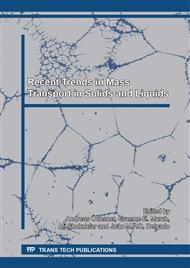p.124
p.135
p.141
p.151
p.161
p.167
p.173
p.181
p.186
Phase Transformations and Recrystallization in Cold-Rolled Al-Mg-Sc-Zr Alloy Prepared by Powder Metallurgy
Abstract:
The mechanical, thermal and electrical properties and recrystallization behaviour of the cold-rolled AlMgScZr alloy prepared by powder metallurgy were studied. The materials were investigated during isothermal annealing (400 and 550 °C) and during step-by-step linear annealing from room temperature up to 570 °C. The observed results were compared with microstructure observation by transmission electron microscopy and electron diffraction from a previous study of the Al–Mg-based alloys with Sc and Zr. The precipitation sequence of the Al–Mg system and coarsening of the Sc,Zr-containing particles caused electrical and heat flow changes during the annealing. The presence of the Al3(Sc,Zr) particles has an anti-recrystallization effect that prevents recrystallization at temperature minimally up to ~ 400 °C. A partial recrystallization of the alloy was registered after annealing at 550 °C already for 30 min. The cause of the anti-recrystallization effect is precipitation of the Mg-containing particles as follows from a comparison to the alloy without Mg. But the Mg-addition to the Al–Sc–Zr alloy prepared by powder metallurgy has a poorer anti-recrystallization effect than a Mn-addition.
Info:
Periodical:
Pages:
161-166
Citation:
Online since:
November 2017
Price:
Сopyright:
© 2017 Trans Tech Publications Ltd. All Rights Reserved
Share:
Citation:


